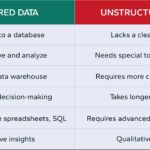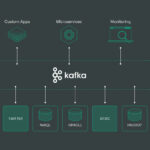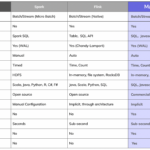Reinforcement learning has emerged as a crucial technique in the realm of autonomous big data pipelines, revolutionizing how data processing and analysis are conducted on a large scale. In this cutting-edge field, reinforcement learning algorithms play a pivotal role in enhancing the efficiency, reliability, and adaptability of big data pipelines, ultimately empowering organizations to extract valuable insights and make informed decisions from massive datasets. This article explores the significant impact of reinforcement learning in driving autonomous capabilities within big data pipelines, highlighting its ability to optimize processes, automate data management tasks, and facilitate intelligent decision-making in the era of big data.
As the demand for big data analytics grows, organizations are increasingly seeking ways to automate and enhance their data processing. One such approach gaining traction is the integration of reinforcement learning (RL) into modern big data pipelines. This article explores the transformative role of RL in creating autonomous systems that enhance data efficiency and decision-making processes.
Understanding Reinforcement Learning
Reinforcement learning is a subset of machine learning where an agent learns to make decisions by taking actions in an environment to maximize cumulative rewards. Unlike supervised learning, where the model learns from labeled data, RL agents learn from the consequences of their actions through exploration and exploitation.
The Importance of Big Data Pipelines
A big data pipeline is essential for processing vast amounts of information quickly and effectively. These pipelines enable organizations to:
- Ingest data from various sources.
- Process and transform data.
- Store and retrieve data efficiently.
- Analyze data to generate insights.
The complexity of these pipelines means they often require sophisticated mechanisms to ensure smooth operation, making the case for autonomously monitored and maintained systems compelling.
Integrating Reinforcement Learning into Big Data Pipelines
By incorporating RL into big data pipelines, organizations can enhance their systems in several ways:
1. Dynamic Resource Allocation
One of the key challenges in big data processing is allocating resources efficiently. RL can optimize resource allocation by learning from historical data and current demands. For example, an RL agent can monitor data flow and adjust resource distribution dynamically. This ensures that data ingestion, processing, and storage components operate at optimal performance levels.
2. Adaptive Data Ingestion
Big data environments often deal with fluctuating data loads. Using reinforcement learning, pipelines can adaptively manage data ingestion rates. An RL agent recognizes patterns in data generation and adjusts the ingestion strategy accordingly, ensuring that systems neither underutilize resources nor become overwhelmed.
3. Predictive Maintenance of Pipeline Components
In an autonomous pipeline, maintaining system health is crucial. RL can monitor the operational status of various components, predicting potential failures before they occur. By analyzing the performance metrics over time, an RL agent can determine the best maintenance schedules, minimizing downtime and maximizing data pipeline efficiency.
4. Error Detection and Correction
Errors in data processing can lead to significant issues, from data quality degradation to complete system failures. Reinforcement learning can help in developing error detection mechanisms that identify anomalies in real-time. The RL agent learns from past errors and optimizes the data processing strategy to minimize future errors.
5. Enhanced Data Quality Control
Good quality data is central to effective decision-making. RL algorithms can be designed to monitor data quality by constantly assessing the incoming data and implementing remediation strategies for low-quality inputs. By rewarding actions that improve data quality, RL can ensure that only the best quality data enters the analytical processes.
How RL Algorithms Operate in Big Data Pipelines
To understand the operational aspects of reinforcement learning within big data pipelines, one must consider the following core components:
1. State Space
The state space represents the various conditions of the pipeline, including current resource utilization, data flow rates, and error rates. Continuous monitoring of these states allows RL agents to understand the environment actively and learn from it.
2. Action Space
The action space consists of all the possible actions the RL agent can take, such as scaling resources, changing ingestion rates, or triggering maintenance protocols. Each action directly affects the state of the pipeline, leading to new states.
3. Reward Function
The reward function defines how the RL agent evaluates the outcomes of its actions. Success in optimizing resource use, ensuring data quality, or mitigating errors could return positive rewards, while failures lead to negative rewards. Crafting an appropriate reward function is key to effective learning.
Benefits of Integrating RL into Big Data Pipelines
The integration of reinforcement learning into big data pipelines offers numerous benefits, including:
1. Increased Efficiency
By optimizing different components of the pipeline, RL contributes to a stark increase in overall efficiency, allowing for faster data processing and enhanced responsiveness to changes in data flow.
2. Reduced Operational Costs
Autonomous decision-making reduces the need for human intervention, leading to lower operational costs associated with staffing and manual monitoring of data workflows.
3. Improved Data Insights
The ability to adapt and learn from ongoing processes leads to improved data insights, equipping organizations with better analytics and forecasting capabilities.
Challenges and Considerations
While the prospects of integrating reinforcement learning into big data pipelines are promising, several challenges need to be addressed:
1. Complexity of Design
Designing an RL system that effectively integrates with existing pipelines can be complex. Specialists in both fields—big data and machine learning—must work together to create coherent architectures.
2. Data Privacy Concerns
As RL agents learn from usage patterns and data flows, there are important data privacy concerns that must be navigated, especially when dealing with sensitive or personal data.
3. Computational Resource Demands
Implementing reinforcement learning algorithms requires substantial computational power, often necessitating investment in infrastructure to process, store, and analyze large datasets seamlessly.
Future of RL in Big Data Pipelines
The future of reinforcement learning in autonomous big data pipelines looks promising, with several exciting possibilities on the horizon:
1. Real-Time Decision Making
Advancements in RL will likely lead to more instantaneous decision-making capabilities, allowing organizations to react in real time to data inflows and system status changes.
2. Enhanced Personalization
As businesses increasingly rely on personalized experiences, RL can drive better recommendations and decision-making processes optimized for the individual user.
3. Continued Evolution of Automated Systems
The integration of RL into big data pipelines will pave the way for fully autonomous systems, where human operators play a minimal role, allowing for seamless data operations across the board.
Conclusion
In summary, reinforcement learning represents a pivotal advancement for big data pipelines, providing organizations with the tools to create more efficient, autonomous, and intelligent systems. By leveraging RL, businesses can optimize resource management, enhance data quality, and improve decision-making processes—all crucial for thriving in a data-driven landscape.
Reinforcement learning plays a crucial role in optimizing and automating autonomous Big Data pipelines. By enabling systems to learn from experience and make data-driven decisions, reinforcement learning enhances efficiency, accuracy, and adaptability in managing and processing large volumes of data. Its integration offers a promising solution to meet the complex demands of Big Data analytics in today’s rapidly evolving digital landscape.














